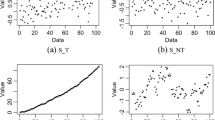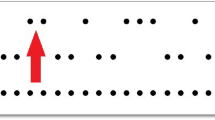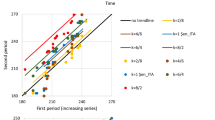Abstract
Autocorrelation and non-stationarity are always concerned in analysis of meteorological and hydrological time series. Current commonly used methods, such as the Box-Pierce (BP) test and Ljung-Box (LB) test, always preset the maximum order for the autocorrelation significance test without considering the existence of high-order autocorrelation coefficient(s), and also neglect a fact that the sum of sample autocorrelation function is a constant value. Moreover, the impacts of autocorrelation on the significance test of nonstationary components of sample time series have drawn much attention, but less attention is paid to the impacts of eliminating nonstationary components on the global autocorrelation significance test. These issues are addressed in the paper. Based on the Monte Carlo method, a global autocorrelation test method, the quadratic sum (QS) test, is presented for judging the existence of high-order autocorrelation coefficient(s) of a sample time series. Besides, two nonparametric trend estimators (nonlinear and linear trend estimators) are employed to investigate the impacts of eliminating nonstationary components on the global autocorrelation test. The results show that (i) the QS test method is more robust than the BP test and LB test in verifying the existence of significant high-order autocorrelation coefficient(s); and (ii) eliminating a linear trend has less damage on the original global autocorrelation structure of sample time series by comparing with eliminating a nonlinear trend. Therefore, it is recommended to initially eliminate the linear trend from a sample time series, and then judge the existence of high-order autocorrelation coefficients of the time series based on the QS test.







Similar content being viewed by others
Data availability
All data included in this study are available upon request by contact with the corresponding author.
References
Bartlett MS (1946) On the theoretical specification and sampling properties of autocorrelated time-series. Suppl J R Stat Soc 8(1):27–41
Blondeau FC (2007) Autocorrelation versus entropy based autoinformation for measuring dependence in random signal. Phys A 308:1–18
Box GEP, Pierce DA (1970) Distribution of residual autocorrelations in autoregressive-integrated moving average time series models. J Am Stat Assoc 65:1509–1526
Breusch TS (1978) Testing for autocorrelation in dynamic linear models. Aust Econ Pap 17:334–355
Brüggeman R, Lütkepohl H, Saikkonen P (2006) Residual autocorrelation testing for error correction models. J Econom 134:579–604
Damos P (2016) A stepwise algorithm to detect significant time lags in ecological time series in terms of autocorrelation functions and ARMA model optimisation of pest population seasonal outbreaks. Stoch Env Res Risk Assess 30:1961–1980
Durbin J, Watson GS (1971) Testing for serial correlation in least square regression III. Biometrika 58:1–19
Fuller WA (1996) Introduction to statistical time series. Wiley, New York
García CA, Otero A, Félix P, Presedo J, Márquez DG (2018) Simultaneous estimation of deterministic and fractal stochastic components in non-stationary time series. Phys D 374–375:45–57
Gasser T, Müller HG (1984) Estimating regression functions and their derivatives by the kernel method. Scand J Stat 11(3):171–185
Godfrey LG (1978) Testing for higher order serial correlation in regression equations when the regressors include lagged dependent variables. Econometrica 46:1303–1310
Hajria RB, Khardani S, Raïssi H (2018) A power comparison between autocorrelation based on tests. Stat Probab Lett 143:1–6
Hamed KH (2008) Trend detection in hydrologic data: the Mann–Kendall trend test under the scaling hypothesis. J Hydrol 349:350–363
Hamed KH (2009) Exact distribution of the Mann–Kendall trend test statistic for persistent data. J Hydrol 365:86–94
Hamed KH, Rao AR (1998) A modified Mann–Kendall trend test for autocorrelated data. J Hydrol 204:182–196
Hassani H (2009) Sum of the sample autocorrelation function. Rand Oper Stoch Equ 17(2):125–130
Hassani H (2010) A note on the sum of the sample autocorrelation function. Phys A 389:1601–1606
Hassani H, Yeganegi MR (2019) Sum of squared ACF and the Ljung–Box statistics. Phys A 520:81–86
Jeong J, Chung S (2001) Bootstrap tests for autocorrelation. Comput Stat Data Anal 38:49–69
Krämer W (1989) On the robust of the F-test to autocorrelation among disturbances. Econom Lett 30(1):37–40
Ljung GM, Box GEP (1978) On a measure of lack of fit in time series models. Biometrika 65(2):297–303
Mantalos P, Shukur G (2008) Bootstrap methods for autocorrelation test with uncorrelated but not independent errors. Econ Model 25:1040–1050
Milly PCD, Betancourt J, Falkenmark M et al (2008) Stationarity is dead: whither water management? Science 319:573–574
Mudelsee M (2019) Trend analysis of climate time series: a review of methods. Earth Sci Rev 190:310–322
Okui R (2009) Testing serial correlation in fixed effects regression models based on asymptotically unbiased autocorrelation estimators. Math Comput Simul 79:2897–2909
Piyoosh AK, Ghosh SK (2017) Effect of autocorrelation on temporal trends in rainfall in a valley region at the foothills of Indian Himalayas. Stoch Env Res Risk Assess 31:2075–2096
Pötscher BM, Preinerstorfer D (2018) Controlling the size of autocorrelation robust tests. J Econom 207:406–431
Robinson PM, Velasco C (1997) Autocorrelation-robust inference. Handbook of statistics, 15:267–298
Saddique N, Khaliq A, Bernhofer C (2020) Trends in temperature and precipitation extremes in historical (1961–1990) and projected (2061–2090) periods in a data scarce mountain basin, northern Pakistan. Stoch Env Res Risk Assess. https://doi.org/10.1007/s00477-020-01829-6
Savin NE, White KJ (1977) The Durbin–Watson test for serial correlation with extreme sample sizes or many regressors. Econometric 45:1989–1996
Sen PK (1968) Estimates of the regression coefficient based on Kendall’s tau. Am Stat Assoc J 63:1379–1389
Serinaldi F, Chebana F, Kilsby CG (2020) Dissecting innovative trend analysis. Stoch Env Res Risk Assess 34:733–754
Serinaldi F, Kilsby CG (2016) The importance of prewhitening in change point analysis under persistence. Stoch Env Res Risk Assess 30(2):763–777
Walker S (2005) Bayesian nonparametric inference. Handb Stat 25:339–371
Wang Y, Chen X, Yan F (2015) Spatial and temporal variations of annual precipitation during 1960–2010 in China. Quatern Int 380–381:5–13
Xie YY, Huang Q, Chang JX, Liu SY, Wang YM (2016) Period analysis of hydrologic series through moving-window correlation method. J Hydrol 538:278–292
Yue S, Pilon P, Phinney B (2002) Cavadias, G. The influence of autocorrelation on the ability to detect trend in hydrological series. Hydrol Process 16:1807–1829
Yue S, Wang CY (2002a) Applicability of pre-whitening to eliminate the influence of serial correlation on the Mann–Kendall test. Water Resources Res 38:4–1–7
Yue S, Wang CY (2002) The null distribution of sample serial correlation coefficient. Stoch Env Res Risk Assess 16:77–100
Acknowledgements
This study was supported by the fund of the State Key Laboratory of Eco-hydraulics in Northwest Arid Region, Xi’an University of Technology (Grant No. 2018KFKT-5) and by China Postdoctoral Science Foundation (Grant No. 2018M642338). Sincere gratitude is expanded to the editor and the anonymous reviewers who provide professional comments for this paper.
Author information
Authors and Affiliations
Corresponding author
Ethics declarations
Conflict of interest
The authors declare that they have no conflict of interest.
Additional information
Publisher's Note
Springer Nature remains neutral with regard to jurisdictional claims in published maps and institutional affiliations.
Rights and permissions
About this article
Cite this article
Xie, Y., Liu, S., Fang, H. et al. Global autocorrelation test based on the Monte Carlo method and impacts of eliminating nonstationary components on the global autocorrelation test. Stoch Environ Res Risk Assess 34, 1645–1658 (2020). https://doi.org/10.1007/s00477-020-01854-5
Published:
Issue Date:
DOI: https://doi.org/10.1007/s00477-020-01854-5




